
Churches and Cathedrals of Manhattan, New York City - 2
Personal notes and information gleaned following a visit October 2003, and features only the churches which I discovered during my seven days in New York. The churches face in all sorts of directions, the descriptions that follow therefore have ritual directions which assumes the high altar is at the east end of the building. The churches are all Roman Catholic, unless otherwise mentioned, and are featured in the order I visited them.
Cathedral of St Patrick (5th Avenue, E50th-51st St)
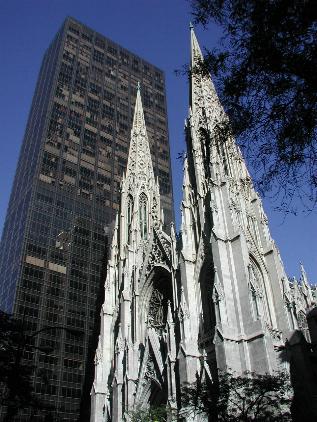 |
This is the USA's largest catholic cathedral
and was built 1858-79 (with a break during the Civil War)
to the designs of James Renwick jr. The spires were
completed in 1885-88 and the cathedral consecrated
debt-free in 1910. Together with its ancillary buildings
it occupies one whole city block between Fifth and
Madison Avenues, 5oth and 51st Streets. It is 332ft long
and the spires reach 330ft. It is also correctly
orientated. The style is a mixture externally of German and French Gothic, and inside more a mix of English and French in feel. The west front with its twin spires is arguably its best feature. Opposite its west doors in the courtyard of the Rockefeller Centre is a statue that appears to show Atlas, which gives an unusual foreground to the photograph on the right. |
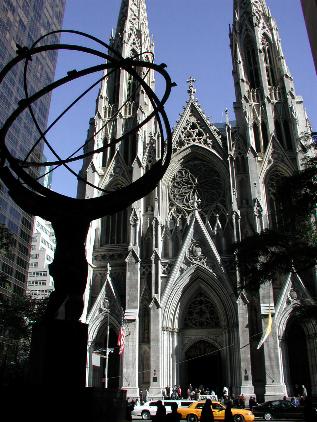 |
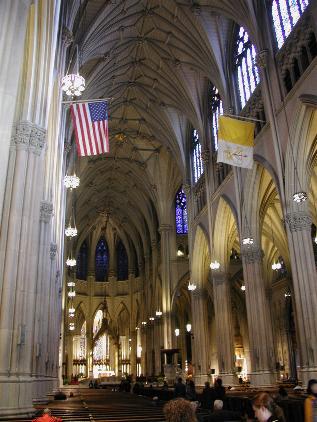 |
In plan the cathedral has the west vestibule
flanked by the towers with gallery above, a further six
bays to the nave with aisles and outer side chapels,
crossing with two-bayed transepts having east and west
aisles, and three-bayed choir with five sided east apse
with aisles/ambulatory and a collection of side chapels
of different sizes, the largest being the Lady Chapel at
the east end which is a later addition of 1901-06 to the
designs of Charles T Matthews. The lierne vaulting to the main roofs is not of stone, but brick and plaster, and this style of vaulting is particularly English in design. However the decision to create double capitals on the arcades in my view was an unfortunate one, giving the top of the columns a sort of knobbliness rather than nobility! The interior is no-where near as light as the camera suggests - the clue is in the lighting which has to be on. Despite that entering from a sunny Fifth Avenue it takes the eyes some time to adjust as every window is filled with stained glass with much use of blue and darker reds, a wonderful jewel-like show, but one which makes the church unnecessarily dark. |
| The High Altar is under a massive baldichino
which is made from solid brass. I found the cathedral open, which it generally is daily from 0730-2030. I luckily avoided visiting during one of the many masses. Unusually for such a touristic honeypot, there was no guidebook on sale apart from a thin leaflet in many languages. This may be a temporary situation though as I already had a well laid-out guidebook at home. |
 |
St Thomas (Episcopal) (5th Avenue, W53rd St)
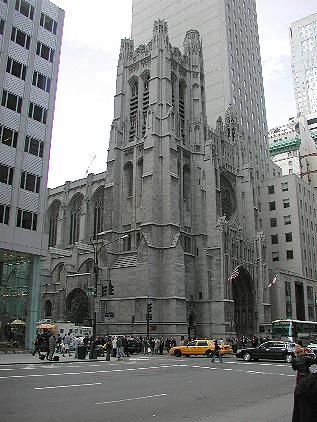 |
This is the fourth St Thomas church, and the
second on this 5th Avenue site. The previous church by
Richard Upjohn opened in 1870 and was destroyed by fire
in 1905. The new church is to the designs of R.A.Cram and
B.G.Goodhue and was built 1911-13. The church is generally described as being in the French Gothic style, yet in my view, apart from the west (actual east) front, it is closest to the English Perpendicular and in particular the way Edwardian architecture in Britain moved towards a modernised Arts & Crafts version of Perpendicular. The nave is wide, eight bays long with passage aisles, from floor to vault apex is 95ft. To the west is the narthex bay with entrance below the gallery and organ above; higher still the west rose window 25ft in diameter with Flamboyant tracery. On the north side an outer chapel, treated like a low nave with four-bayed arcades and narrower east sanctuary. The east two bays of the nave serve as the choir and there is a slightly lower and narrower sanctuary, its east wall filled by a magnificent reredos with three stepped openings near the top for windows. Lee Lawrie and B.G.Goodhue designed it, incorporating in it a replica of the original much smaller altarpiece destroyed in 1905. |
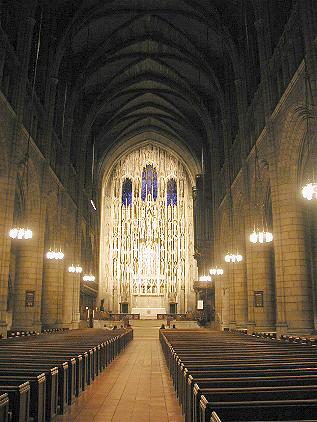 |
The choir stalls are later, given as a World
War One memorial and among the carvings are a radio and a
telephone. These two interior shots are greatly altered on the computer as despite the lights being on the interior was very dark. What stays in the memory are the two main pieces of theatre, the west front onto Fifth Avenue and the reredos screen inside which appears floodlit among the intense gloom. There are some better pictures on the church's website with a fuller history and description. |
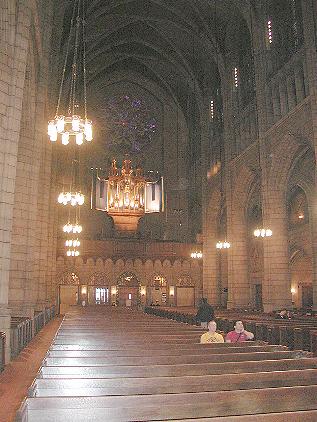 |
Fifth Avenue Presbyterian Church (5th Avenue, W55th St)
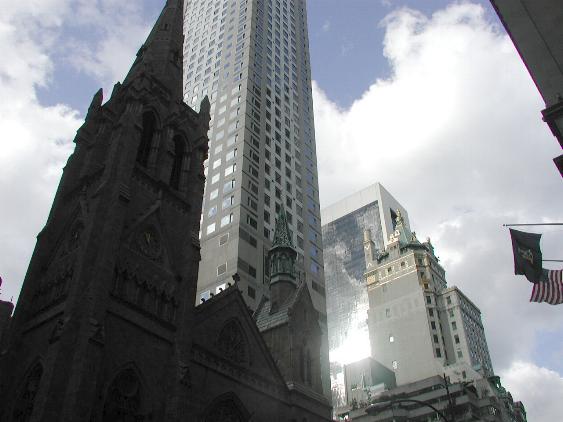 |
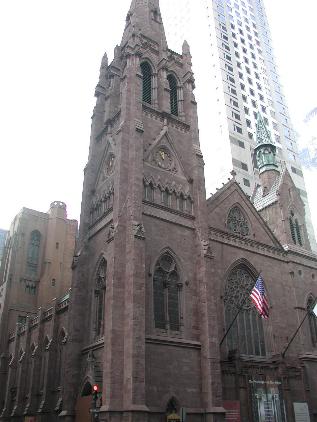 |
Two blocks north and another much different church sits on the NW corner. Built 1873 - 75 and designed by Carl Pfeiffer, the church was closed and undergoing a thorough restoration when I visited (October 2003). Not satisfied with one, or even two towers, this one has three, and all very different. Two towers flank the west (actual east) front. The NW tower is the largest, of four stages with stubbly pinnacles and a recessed spire. The SW tower is smaller, with a saddleback top which carries a large polygonal turret and spire. Behind at the NE corner is a much plainer tower in a later C15 style, of different stone too and probably a later addition. (Is this the Parish House? If so it dates from 1925 and was designed by James Gamble Rogers.) This angular second pointed church is in sharp contrast to the sugary confections of St Pats and St Thomas to the south. (Its neighbours further north are a massive skyscraper and another smaller one which appears to have a French Chateaux elevated upards towards the sky! - see picture above left).
The church has an excellent website with a virtual tour. The interior is amazing. The parish house complex also has a "Chapel" like a seperate church holding 400-500 people with nave, south aisle with gallery and chancel. A series of photogalleries means you can follow the work in progress too.
<BACK> <MANHATTAN INDEX> <NEXT>
page updated 26th March 2005